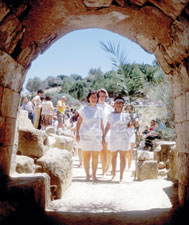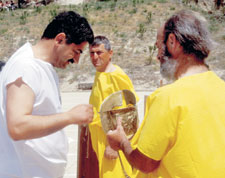by Brent Harris, Director of Sports Information
 | |
| Runners compete. |
Steve Miller ’64 uncovered an archaeologist’s dream at Nemea, Greece: the Temple of Nemean Zeus, constructed 330 B.C; a stadium for athletic games that pre-date the Olympics; the only ancient locker room ever recorded, as well as the tunnel that connected that locker room to the stadium—a tunnel where ancient athletes etched graffiti into the walls.
The site has revealed so much about the details of ancient athletic contests that Miller has written two critically acclaimed books to describe them.
Yet his most unexpected and remarkable find in 30 years of working at Nemea has been, as he says, “not a discovery of an antiquity, but of the human spirit.”
“In 1995, a group of local people—farmers, lawyers, bankers, doctors—came together to found the Society for the Revival of the Nemean Games,” Miller says in a film publicizing the 2004 New Nemean Games. “It was their notion that the discoveries that I had made at Nemea could be the base for an international festival where anyone and everyone could participate.”
In 1996, and again in 2000, more than 1,300 men, women, and children, ages 10 to 93, came from 45 countries to take part in these revived games. They returned in even greater numbers this summer—donning tunics in the ancient locker room, walking through the tunnel, placing their toes on the grooved starting line where athletes first sized each other up 2,500 years ago, and running for ribbons, palm branches, and the victor’s crown of wild celery.
 | |
|
Participants from Thailand, France, and Norway prepare to walk through the ancient "tunnel" between the locker room and stadium.
|
“They stepped back in history,” Miller says. “And in doing so, became a part of our enduring quest for peaceful competition through our common humanity.”
From the laughter, embraces, and high-fives exchanged by competitors shown in the film, they had a great time doing it, too.
All of this might never have happened if Miller’s dream for his Wabash career had come true. Miller wanted to be a lawyer.
“After taking political science and economics courses, I decided very quickly to move away from that particular vocation,” Miller says. “Then I had the opportunity to learn Ancient Greek, and in my sophomore year, an archaeologist came to Wabash. His presentation mesmerized me.”
Today, Miller is a professor of classical archaeology at the University of California-Berkeley and among the most respected in his field. He returned to Nemea as a respected friend and inspired contributor to the community as he helped celebrate the third New Nemean Games in July.
But Miller was not the most welcomed person in the Greek village when he began excavating in 1973. He angered two wealthy families in the area by hiring workers from the village that would normally work for lower wages. In 1980, he was shot at while working in the area. Today the scene is much different.
“The whole village gets involved in the Games,” he says. “A few days ago I ran into an older man from the village. We haven’t spoken in six or eight years. He stopped me and said, ‘I wanted to let you know I’m coming to the Games this year.’ It’s a sign that some of the old wounds are healing.
“A workman and I were talking a few days ago. He was born after I started my work on the site in 1973, and his family has been working the site for years. Now he’s about to have his first child. I’ve actually seen the history passed from one generation to another. There’s a sense of pride, involvement, and ownership by the people of Nemea.”
The Games have also been a boon to travel to the area.
“Last year official Greek tourist figures showed a 20-percent drop in travel. We saw an increase of 18 percent in the number of people visiting the site at Nemea,” Miller says. “It’s definitely being discovered.”
Wabash students are discovering Nemea and Miller’s work there. Classics professor John Fischer led his students there as part of an immersion experience last year, and Professor Joe Day is using Miller’s books—Ancient Greek Athletics and Arête: Greek Sports From Ancient Sources—to teach a course on the history of Greek athletics.
 | |
| The Mayor of Nemea draws his lane assignment from a helmet held by Professor Steve Miller, as U.S. ambassador to Greece Nicholas burns casts a watchful eye. |